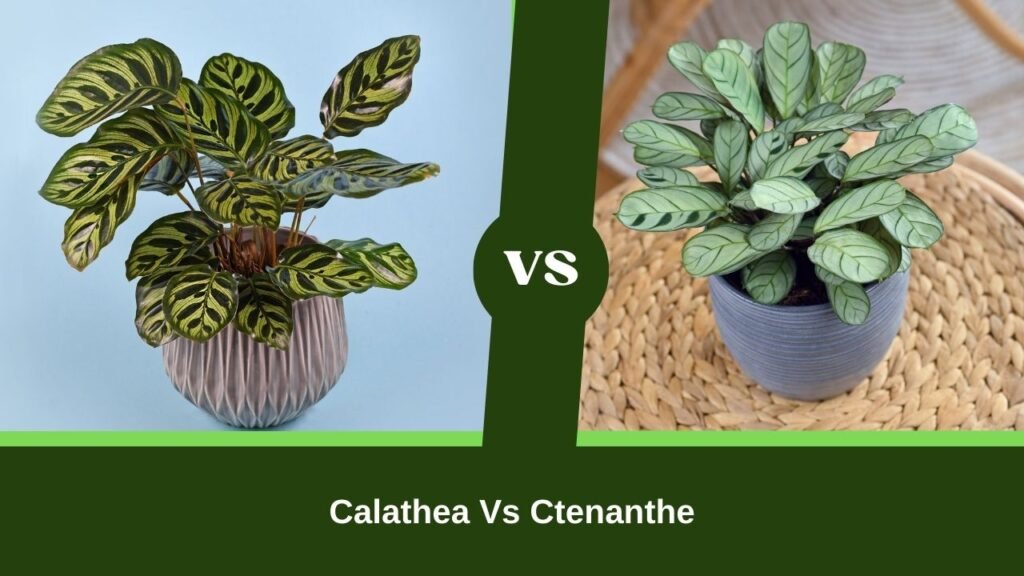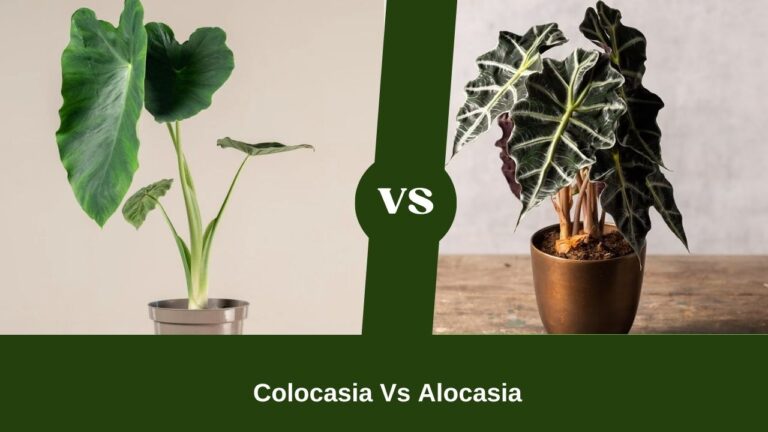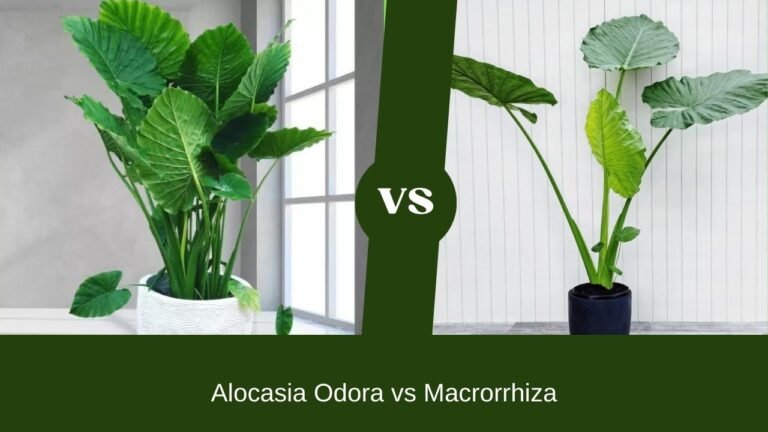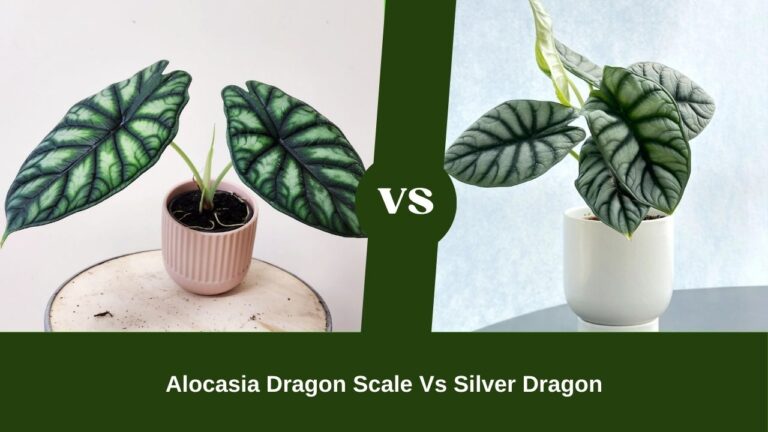Calathea vs Ctenanthe: How Do These Prayer Plant Cousins Compare?

Calathea and Ctenanthe have captivated plant parents with their colorful leaves and unique movements. But what exactly distinguishes these two prayer plant cousins?
Basically, they have a lot of similarities. But a few differences including the appearance and availability. Calathea is commonly found, but visual appeal might not touch the note. Cteananthe makes a more impressive visual but isn’t as common and has as much variety as Calathea.
Let’s find out how the plants are different from each other. Have a look at how they match your criteria and decide which one to choose.
Table of Contents
Getting to Know Calathea and Ctenanthe

Before discussing this in detail, let’s see some basic differences between Calathea and Ctenanthe.
First, a quick rundown of their key traits. Let’s take a look and get an idea about how different the plants are from each other.
| Criteria | Calathea | Ctenanthe |
| Common Name | Calathea, Prayer Plant | Giant Bamburanta |
| Scientific Name | Calathea (Goeppertia) sp | Ctenanthe spp. |
| Family | Marantaceae | Marantaceae |
| Plant Type | Perennial Indoor Plant | Perennial Indoor Plant |
| Toxicity | Non-toxic | Non-toxic |
| Life Span | Several years of proper care | Several years with proper care |
| Size | Varies by species, typically 1-3 feet tall | 12-18 inches tall |
| Leaves | Varied shapes and colors, intricate patterns | Long oval leaves with unique patterns |
| Flowers | Insignificant flowers | Insignificant flowers |
| Roots | Fibrous root system | Fibrous root system |
| Stems | Non-woody, leafy stems | Non-woody, leafy stems |
| Growth Habit | Clump-forming, bushy | Clump-forming, bushy |
As members of the Marantaceae family, Calathea and Ctenanthe hail from tropical environs and share a need for warm, humid conditions. But they have marked differences in appearance and care needs.
Is Ctenanthe Emphasize A Colorful Persona?
Yes! When it comes to looks, the Ctenanthe oozes eye-catching appeal with its gorgeously graphic leaves.
Many Ctenanthe species flaunt leaves with drastically light and dark areas, creating sharp, striking contrasts. Think broad bands of grey-green and deep green or white and dark green zig-zagging together.
Meanwhile, most Calathea cultivars have leaves with a single color and delicate pinstripes or splotches for more subtle interest. Their softer colors blend together for a more subdued look.
So if you’re seeking a prayer plant with high visual drama, Ctenanthe is sure to dazzle and delight with its bold, striped foliage patterns.
When Does Calathea Defeated Ctenanthe?
When you talk about the variety and availability, Calathea tops the chart. If finding a prayer plant feels like searching for a needle in a haystack, go for Calathea.
While Ctenanthe offers graphic beauty, the selection is far more limited. Fewer varieties exist and they’re often hard to source.
With Calathea, the options abound! Dozens of cultivars come available in a range of heights, leaf shapes, and colors. And their popularity makes them readily accessible.
Whether you love the rippled leaves of the Calathea medallion or the purple accents of the Calathea makoyana, you’ll have selections to suit your style.
So for abundance and accessibility, Calathea takes the cake. Discover new favorites from an array of fantastic options!
6 Key Commonalities of Calathea and Ctenanthe
Here are some of the key similarities between Calathea and Ctenanthe plants:
1. Tropical Heritage
Both Calathea and Ctenanthe originate from tropical environments and thrive in warm, humid conditions that mimic their native regions.
2. Prayer Plant Movement
These plants exhibit fascinating prayer plant movements, with leaves that raise and lower throughout the day to follow the light.
3. Vibrant Foliage
They are adored for their beautifully patterned, vividly colored leaves in shades of green, pink, red, white and purple.
4. Pet-Friendly
Calathea and Ctenanthe are non-toxic to pets, making them safe choices for homes with curious cats and dogs.
5. Air Purifying
Their large, foliage helps remove toxins like formaldehyde, benzene, and trichloroethylene from indoor air.
6. Low Maintenance
When provided with suitable conditions both plants are relatively low maintenance, without the need for pruning or complicated care.
So in many respects, Calathea and Ctenanthe share core qualities – yet each offers its own unique flair and beauty. By understanding their similarities and differences, you can pick the perfect prayer plant for your space!
5 Fascinating Facts About These Prayer Plants
There are some amazing things about these plants. Let’s take a look.
- They fold their leaves up at night like praying hands – hence the name prayer plants!
- The undersides of the leaves have brilliant colors, like deep purple.
- They enjoy tropical conditions – warm temps and high humidity.
- They move their leaves to follow the light throughout the day.
- The leaves can be damaged by direct sun, cold drafts, and dry air.
Recommended articles:
FAQs
Have questions about adding Calathea or Ctenanthe to your indoor oasis? Here are some handy answers:
Q: What’s their ideal temperature range?
They thrive with temps between 65-80°F. Below 55°F causes cold damage.
Q: How much light do they need?
Bright indirect light is essential. The direct sun scorches their leaves!
Q: How often should I water them?
Water when the top inch of soil dries. Keep soil consistently moist but not soggy.
Q: What’s the best way to increase humidity?
Group plants together, use a humidifier, or place pots on pebble trays to reach 60% humidity or higher.
Q: Should I mist my prayer plants?
Occasional misting boosts humidity nicely, but avoid wetting the leaves in strong light.
Final Choice
Seeking a touch of the tropics? With vividly patterned leaves and charming movements, Calathea and Ctenanthe bring drama and interest inside.
Choose Ctenanthe for bold striped statements, or pick from Calathea’s copious selection for gorgeous variety. Either way, your indoor jungle will certainly rejoice!






